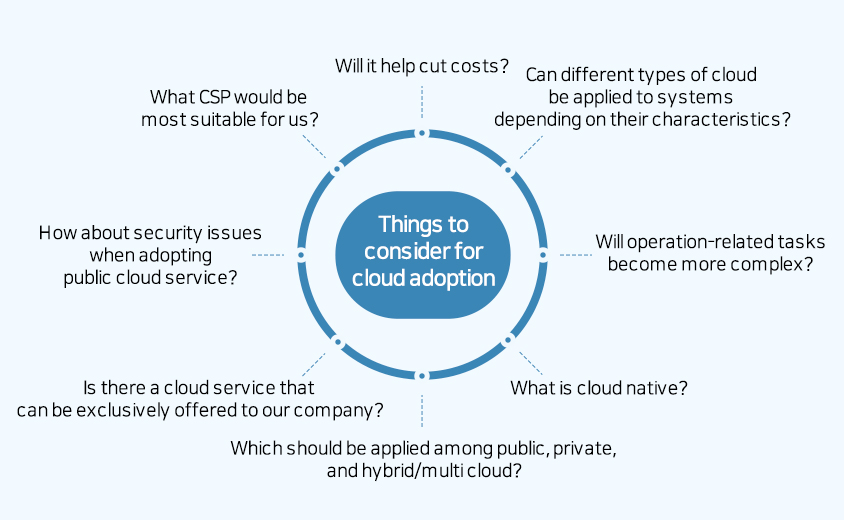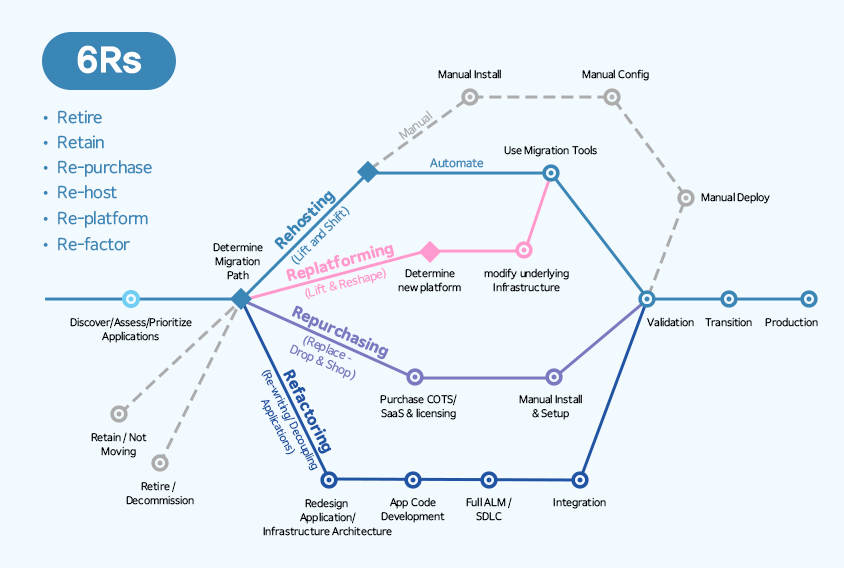
Digital-native architecture has been one of the key interests of companies that are pursuing digital transformation to strengthen competitiveness in recent days. Global tech giants referred to as FAANG—acronym for Facebook, Amazon, Apple, Netflix, and Google—are gaining stronger presence and competitiveness as digitally-native companies, while traditional forms of business are falling behind in the competition. And cloud computing is the technology that serves as the basis of such digital-driven transformation.
Nowadays, not only startups and small and medium-sized businesses (SMBs) but also major companies are shifting to the cloud environment in order to achieve digital transformation. Cloud adoption strategies adopted by companies will differ depending on the size and characteristics of the companies. So in today’s article, we will explore various strategies for transitioning to the cloud that can minimize risks while maintaining effectiveness.
Cloud Adoption Strategies

The first thing to consider when companies seek cloud adoption is the type of cloud service to be applied to its system among public cloud, private cloud, and hybrid/multi cloud. The use of private cloud or hybrid cloud is associated with concerns over cost as well as consideration of compliance and internal control-related issues. But in the case of companies that have little compliance issues, it is advisable to use a public cloud that can be freely accessed.
When choosing to adopt a public cloud, there is another decision to be made by companies, which is the question of what to choose among the various types of public cloud services including Amazon Web Service (AWS), MS Azure, Google Cloud Platform (GCP), and Samsung Cloud Platform (SCP). (Well of course, even major public cloud providers like AWS, Azure, and SCP also offer private cloud services such as AWS Outposts or SCP Private Cloud in the CSP sector.) While AWS currently holds the largest market share, other players in the CSP market are also making a push through unique strategies of their own. As such, the process of comparing and analyzing various public cloud services to pick the one that best suits a company’s needs is a difficult yet highly essential procedure. Through this process, companies can have a clear grasp of the key features and advantages of each CSP and determine which cloud service will be optimal for their systems. In addition, it will be helpful for companies to build internal capacity for devising strategies to adopt advanced forms of cloud in the future.
After selecting which cloud to adopt, it is advisable for companies to implement the cloud environment starting from the test and development systems that entail the lowest amount of risk and cost. As test and development work do not affect the business itself, projects can be conducted right away on the cloud without making pre-investment on infrastructure or software. Through such process, operators and developers can have a chance to experience the cloud systems and attain relevant technological capabilities.
Then, how about companies that are preparing to launch a new service? Before the introduction of cloud services, companies had to make investment into all systems and servers required for the cloud environment by estimating the years of capacity needed from the start to the growth of business and in turn purchasing servers, storages, network devices, and software in advance. It took much time to estimate the required capacity, and inaccurate projections often led to system failures or huge financial losses resulting from overinvestment. And in case companies decided to withdraw business, all the facilities and software that had been invested exclusively for the business became obsolete. Therefore, it is critical for companies to take into account the size, simultaneous access, and traffic volume of their service and accordingly choose a cloud service that enables configuration of systems with scalable infrastructures and flexible traffic management, which will allow them to minimize risks when establishing a system for their new service.
Cloud Migration
In order to adopt cloud, a process called cloud migration should also be carried out, through which the data and applications of existing legacy systems are transferred to a new environment. Cloud migration, which serves as the starting point of digital transformation, is a top concern for IT companies that operates IT systems. Thorough preparation and diagnosis are highly necessary especially in the case of companies with sizable systems running in various environments. Thus, it will be more effective to conduct cloud migration after completing overall preparation and analysis of systems through Migration Readiness Assessment (MRA)*, Migration Readiness & Planning (MRP)*, and Cloud Adoption Framework (CAF)*.
*MRA: process of evaluating corporate IT assets and checking the overall status of preparation for cloud migration
*MRP: process in which preparation and analysis of customer needs are conducted to choose the subjects of cloud migration
*CAF: process of establishing an implementation plan by analyzing systems from various viewpoints such as business capacity (strategy, workforce, governance) and technological competence (platform, security, operation) to facilitate cloud migration
Building on such process, companies can set up the cloud migration strategy for their systems based on the 6Rs: Retire, Retain, Re-host, Re-platform, Re-factor, and Re-purchase. First, companies should sort out the systems to be removed (retire) and those to be phased out without migrating to the cloud (retain). Then, they should discern whether to move the systems to the cloud either by making no changes at all, by converting the platform, or by changing the structure of the applications, after analyzing the systems in terms of migration technologies and costs. Here, an important thing to consider is the fact that such decision is increasingly affected by the risks deriving from technological difficulties as well as costs. This method of migrating all the on-premises systems to the cloud and initiating new IT services on the cloud is referred to as the “cloud first” strategy, which is implemented by many companies of nowadays.

6Rs
• Retire: eliminating IT systems currently in use
• Retain: maintaining the IT systems and then phasing them out in the future
• Re-purchase: converting IT systems using SaaS
• Re-host: moving the existing IT environment as it is to the cloud (Lift & Shift)
• Re-platform: migrating by converting the existing platforms (OS, DBMS, middleware, etc.) into the ones offered on the cloud
• Re-factor: shifting the application workload to cloud native architecture by using services provided on the cloud (through MSA, container, serverless, etc.)
Let’s put this into perspective by looking at the example of a startup that is starting a new service and an SMB that already has existing systems. In the case of a startup newly launching a service, it is advisable to use a public cloud service as the company can set up application systems by using the various types of IaaS and PaaS services offered by cloud providers while applying SaaS to the systems for work such as HR and CRM. On the other hand, for an SMB that has existing legacy systems, it is recommendable to first migrate its test and development systems to the cloud as a test run, and then also operate its new services in the cloud environment as well as other systems one after another.
In the case of medium to large-sized companies, the migration process becomes much more complicated, as such companies already have various types of IT systems and applications in place. Therefore, they should more thoroughly prepare for their cloud migration from a company-wide perspective, and systematically shift their systems to the cloud by applying methodologies (MRA, MRP, CAF, 6Rs, etc.) suitable for their needs.
Cloud has now become an integral part of digital transformation that cannot be overlooked. Using cloud services in a way that is optimal for the circumstances of each company will surely lead to raising the overall competitiveness of their business.

